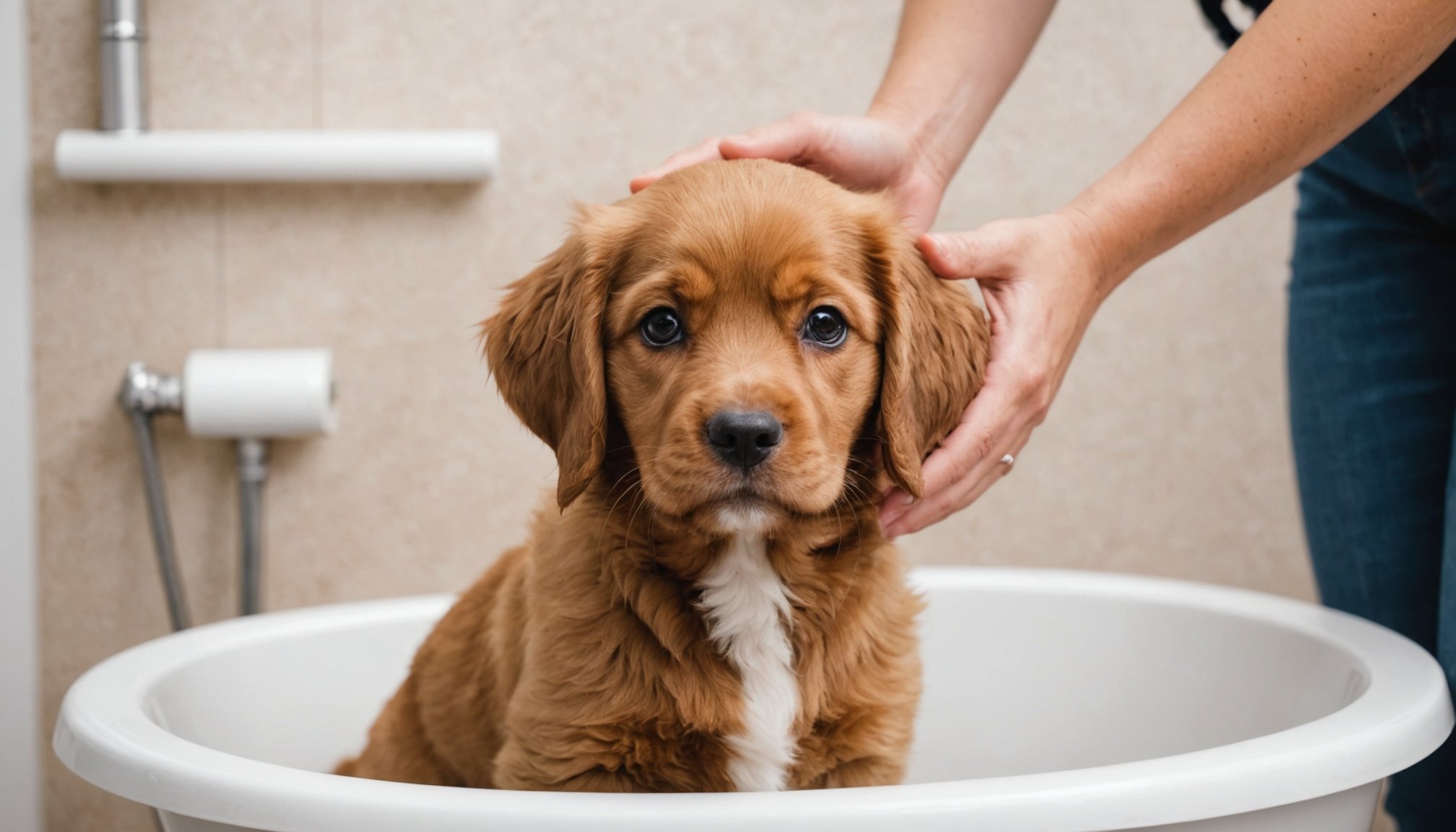Importance of Early Grooming for Puppies
Introducing puppy grooming at an early age holds numerous benefits. Grooming isn’t just about maintaining appearance; it plays a crucial role in shaping a puppy’s behaviour and fondness for hygiene routines.
Early grooming benefits include helping puppies become accustomed to the sights, sounds, and sensations involved in the process. By starting young, owners can create a stress-free grooming environment, which is pivotal in ensuring a positive experience. Puppies that are not groomed early on may develop anxiety or fear, making future grooming sessions challenging for both the pet and the owner.
Have you seen this : Teach Your Dog to Tackle Household Tasks: A Fun Guide to Canine Chores
Establishing a grooming routine helps build trust between the owner and the puppy. Regular grooming sessions teach young dogs to remain calm and enjoy human touch, setting a foundation for positive social interactions throughout their lives. This routine proves invaluable, especially if the puppy needs medical examinations or treatments that require handling.
Moreover, early puppy grooming contributes to better long-term behaviour, encouraging cooperation and reducing fidgeting during various activities. Ultimately, consistent grooming from a young age not only keeps the puppy clean and healthy but also nurtures a strong, trusting bond between pet and owner, facilitating future grooming efforts.
Additional reading : Mastering Vet Visits: Tips for Easing Your Dog”s Anxiety at the Clinic
Preparing Your Puppy for Grooming Sessions
Preparing your puppy for grooming sessions requires thoughtful planning and careful introduction. Here’s how to ensure a smooth experience.
Choosing the Right Tools
The first step in puppy preparation is selecting appropriate grooming tools. Your choice of tools impacts the grooming experience immensely. Focus on brushes and combs suitable for your puppy’s coat type. Clippers and trimmers should be puppy-friendly, minimizing noise and vibrations to avoid anxiety. Selecting quality grooming tools not only makes the process smoother but also helps in maintaining your puppy’s coat in top condition.
Creating a Comfortable Space
A stress-free environment is crucial for a successful grooming session. Consider setting up a designated space where the puppy feels safe. This could be a familiar area, like a bathroom or a corner of the living room, away from distractions. Use calming music or white noise, and ensure all grooming tools are within reach. Creating a calm atmosphere will reassure your puppy and make future sessions more enjoyable.
Gradual Introduction to Grooming
Introducing your puppy to grooming should be gradual. Begin with brief sessions using familiarization techniques. Allow the puppy to explore the grooming tools first. Gradually perform more grooming tasks, starting with a simple brush, before progressing to more involved tasks like nail clipping or bathing. Consistent positive reinforcement with treats can help your puppy equate grooming with a pleasant experience.
Step-by-Step Grooming Techniques
Understanding grooming techniques is crucial when it comes to maintaining your puppy’s health and well-being. The process involves several steps that, if followed carefully, ensure your puppy remains clean and comfortable.
Bathing your puppy requires special attention. Begin by using lukewarm water and a gentle, puppy-specific shampoo. Wet your puppy thoroughly, avoiding the eyes and ears, and apply shampoo. Rinse completely to ensure no residue remains. A thorough rinse will prevent irritation and dryness of the skin.
Brushing and combing are vital in the grooming process. Regular brushing helps to reduce shedding and tangles. Use a soft brush suited for your puppy’s coat type, be it short or long. Start from the head, moving towards the tail gently, ensuring you cover the undercoat as well. This practice not only maintains a healthy coat but also strengthens the bond with your pet.
Nail trimming and ear cleaning are integral parts of puppy grooming. For nail trimming, secure a comfortable position, and use a pet-specific nail clipper. Aim to cut the tip only, avoiding the quick. When it comes to ear cleaning, moisten a cotton ball with a vet-approved cleaner and wipe the inner ear gently. Employing positive reinforcement throughout these activities ensures your puppy associates grooming with a rewarding experience, encouraging cooperative behavior.
Building a Positive Association with Grooming
Establishing a positive reinforcement routine ensures your puppy associates grooming with enjoyable experiences. Begin with simple, gentle actions paired with treats and verbal encouragement. Over time, this consistent praise helps build trust.
Reward Systems
Effective use of treats and praises plays a crucial role in creating comfort. When introducing a grooming tool, offer a treat to reinforce that it is not something to fear, fostering a positive association. Reward with treats or a favourite toy immediately after grooming sessions to associate the process with positivity.
Creating a Calm Atmosphere
Maintaining a calming environment is vital. Play soothing music or use a soft voice to ease your puppy’s nerves during grooming. The right setting can significantly reduce anxiety and make grooming a peaceful experience. Keep the space free of distractions to focus your puppy’s attention on the task at hand.
Socializing Your Puppy
Social exposure is essential in lowering grooming-related anxiety. Regular interactions with different dogs and people help your puppy become adaptable to various situations, including grooming. Early and frequent exposure boosts their confidence, making them more receptive to grooming routines. Socialization fosters a pathway to comfort, ultimately making grooming a hassle-free task.
Troubleshooting Common Grooming Challenges
When it comes to puppy care, grooming challenges are often at the forefront of a pet owner’s concerns. How do you address your dog’s fear of grooming tools? The key is gradual exposure and positive reinforcement. Start with short sessions, allowing them to sniff and explore the tools without the pressure of immediate grooming. Reward them with treats and praise when they remain calm.
A puppy exhibiting anxiety or aggressive behaviour during grooming can be particularly daunting. Identifying the root cause is essential. Is your pet scared, or does a specific grooming action trigger discomfort? Try desensitization by slowly introducing the grooming routine in a calm environment. Play soft music and use gentle, reassuring tones to create a soothing atmosphere.
Sometimes, the issues might be beyond what training at home can solve. Knowing when to consult a professional groomer can be invaluable. If your pet’s anxiety or aggression escalates, seek the expertise of a certified groomer who specializes in handling complex behaviours. They often have the experience and tools to ensure safe and effective grooming, which can alleviate stress for both you and your puppy.
Expert Tips and Anecdotes
When it comes to grooming puppies, relying on expert advice is essential. Professional groomers often have years of expertise and insights that can make a world of difference in maintaining your puppy’s coat health. One such expert, Amanda, a certified groomer with over a decade of experience, emphasizes understanding the unique characteristics of each breed. She shares that using the correct grooming tools tailored to a puppy’s specific coat can significantly improve the grooming experience, making it less stressful for both pet and owner.
Success stories from puppy owners abound, illustrating the importance of adapting grooming practices to individual needs. Take Sarah, for example, who shared her experience with her spaniel named Max. Initially, Max was afraid of grooming sessions, but with patience and a few tips from a grooming expert, such as using treats for positive reinforcement and starting with short, frequent grooming periods, Max now enjoys his grooming routine.
Anecdotal evidence like Sarah’s demonstrates that by tailoring grooming methods to suit your puppy’s temperament and coat type, grooming can become a bonding activity rather than a chore. Listening to advice from those with personal experience and professional insight can guide you in creating a seamless—and enjoyable—grooming regimen for your furry friend.
Visual Aids and Additional Resources
Understanding how to groom your pet effectively can be greatly enhanced with visual learning tools. By utilising various grooming resources, pet owners can transform tedious tasks into enjoyable experiences.
Recommended Videos
Instructional videos are a fantastic resource for pet grooming. These videos often cover a wide range of pet grooming techniques, from basic brushing to more specialised care for different breeds. They offer step-by-step guidance, showing exactly how to hold tools or position your pet for maximum comfort. Video content is particularly beneficial because it showcases actual demonstrations, making it easier to visualize and mimic techniques.
Articles and Guides
Expand your knowledge with informative articles and guides. These written resources often delve into the specifics of pet grooming, offering insights into the best products to use, safety precautions, and the ideal grooming frequency for different animals. Well-written guides often incorporate expert opinions and provide verified suggestions which increase reliability and trustworthiness.
Community Support
Engaging with online pet grooming communities can also be incredibly helpful. These forums provide a platform for pet owners to share their experiences, seek advice, and recommend effective grooming resources. By participating in these communities, individuals can gain insights from various perspectives and find camaraderie in shared interests.











